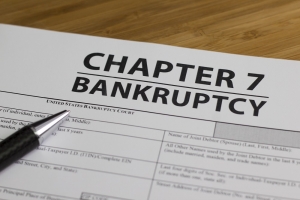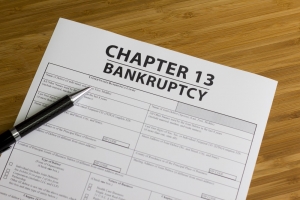Introduction to The Bankruptcy Trustee
 When an individual files for bankruptcy, the court will assign a person who is called the bankruptcy trustee. The bankruptcy trustee has an active role in both Chapter 7 bankruptcy and Chapter 13 bankruptcy cases. The bankruptcy trustee can be thought of as the middle man between the individual filing for bankruptcy and the judge presiding over the bankruptcy proceeding. Even though the bankruptcy trustee is acting closely with the individual who filed for bankruptcy, they are NOT representing that individual. [i] The bankruptcy trustee technically represents the bankruptcy estate itself.[ii] The role of the bankruptcy trustee vary depending on the type of bankruptcy filed, but either way there are a lot of similarities.
When an individual files for bankruptcy, the court will assign a person who is called the bankruptcy trustee. The bankruptcy trustee has an active role in both Chapter 7 bankruptcy and Chapter 13 bankruptcy cases. The bankruptcy trustee can be thought of as the middle man between the individual filing for bankruptcy and the judge presiding over the bankruptcy proceeding. Even though the bankruptcy trustee is acting closely with the individual who filed for bankruptcy, they are NOT representing that individual. [i] The bankruptcy trustee technically represents the bankruptcy estate itself.[ii] The role of the bankruptcy trustee vary depending on the type of bankruptcy filed, but either way there are a lot of similarities.
The Chapter 7 Bankruptcy Trustee
When you file for bankruptcy, the court will appoint the bankruptcy trustee to your case. The trustee has a lot of duties when it comes to overseeing the bankruptcy case.[iii] To begin with, a Chapter 7 bankruptcy is commonly referred to as the liquidation bankruptcy.[iv] This is because the individual filing for bankruptcy must allow the bankruptcy trustee to sell off all nonexempt property items in an attempt to pay off as many of the creditors as possible.[v] In some scenarios, an individual will not have enough property to sell off, or any property worth value, so the trustee will not be required to sell any property off.[vi]
 On top of selling off nonexempt property, Chapter 7 bankruptcy requires a lot of paperwork and disclosure about financial assets and income of the individual who is filing. The first duty of the trustee is to review the bankruptcy petition itself and the supporting documents.[vii] The individual who is filing for bankruptcy has to provide financial information about their debts, property, income, and the overall state of their financial affairs.[viii] These documents are all required by the court. In addition to those documents, the individual filing for bankruptcy will have to turn in pay stubs, tax returns, and information about assets to the bankruptcy trustee.[ix] The bankruptcy trustee will then review the bankruptcy petition and check to make sure that everything is correct and accurate with the documents that the individual provided to the trustee.[x]
On top of selling off nonexempt property, Chapter 7 bankruptcy requires a lot of paperwork and disclosure about financial assets and income of the individual who is filing. The first duty of the trustee is to review the bankruptcy petition itself and the supporting documents.[vii] The individual who is filing for bankruptcy has to provide financial information about their debts, property, income, and the overall state of their financial affairs.[viii] These documents are all required by the court. In addition to those documents, the individual filing for bankruptcy will have to turn in pay stubs, tax returns, and information about assets to the bankruptcy trustee.[ix] The bankruptcy trustee will then review the bankruptcy petition and check to make sure that everything is correct and accurate with the documents that the individual provided to the trustee.[x]
Once the bankruptcy trustee has gone over all the documents against the petition and determined that everything has checked out, the bankruptcy trustee will conduct what is called a 341(a) meeting of creditors.[xi] A 341(a) creditor meeting is a mandatory meeting for the individual filing for bankruptcy.[xii] The meeting must be set at least 21 days after the bankruptcy petition has been filed, but no later than 40 days.[xiii] The bankruptcy judge is not present at this proceeding, rather the bankruptcy trustee is the person who conducts the meeting.[xiv] One reason for this meeting is the debtor’s creditors to come forward and ask the debtor questions.[xv] Creditors may attend this meeting if they believe that the debtor is hiding assets or has completed unlawful transfers before the bankruptcy petition was filed.[xvi] However, if the creditor does not have a reason to believe anything along those lines, they will generally not appear at the meeting. The meeting is also a way for the bankruptcy trustee to examine the individual filing for bankruptcy about their financial assets and all the financial documents they provided, and this is done so under oath.[xvii]
Another duty of the bankruptcy trustee is the liquidation process, as briefly discussed above. Every state has their own list of exemptions for individuals going through the bankruptcy process. Once the bankruptcy trustee determines what property the individual has that is exempt, they will determine which of the nonexempt property is worth trying to sell off.[xviii] The trustee also has the ability to say that there is nothing of value to be sold, and notice will be given to the creditors that they will not receive any funds through this procedure.[xix]
The bankruptcy trustee also has the ability to avoid any preferential transfers or improperly executed security interests.[xx] What this means is if the debtor transfers all of their savings to a family friend to hide or if the debtor decides to pay off a debt to a friend rather than a secured creditor – the bankruptcy trustee can reverse these transactions.[xxi] The transfer must usually take place within 30 – 90 days before filing the bankruptcy petition, but that time period could change depending on the state where the bankruptcy is being filed.
The Chapter 13 Bankruptcy Trustee
There is also a trustee assigned to the bankruptcy proceeding for a Chapter 13 bankruptcy. A Chapter 13 bankruptcy proceeding is the repayment plan option.[xxii] Once the debtor files for Chapter 13 bankruptcy, a bankruptcy trustee is assigned to the case. The individual who files for bankruptcy creates a repayment plan that they will follow for the following three to five years.[xxiii] The debtor will create this plan by using all the documentation they have gathered for the court – including information about their monthly expenses, incomes, debts, credit cards, and any other relevant financial information.[xxiv] After the debtor has created the repayment plan using their financial information, the bankruptcy trustee assigned to the case will review everything.[xxv] This will include looking at the debtor’s financial statements, as they have provided the documents, and review the repayment plan.[xxvi] The bankruptcy trustee will do more than just cross-reference the data to make sure it is all accurate – the bankruptcy trustee has the ability to reject the repayment plan.[xxvii] The bankruptcy trustee can say that the repayment plan is not sufficient for any number reasons including whether or not the amount the debtor wants to pay to creditors is a reasonable amount.[xxviii] The bankruptcy trustee can reject a repayment plan and tell the debtor to increase the amount given to creditor if the debtor has more disposable income than is necessary.
 Again, the bankruptcy trustee will conduct the 341(a) creditor meeting. At the meeting the bankruptcy trustee will be able to review and verify the information the debtor has provided for the repayment plan, while under oath.[xxix] The 341(a) creditor meeting will also give any creditors the opportunities to question the debtor in regards to their assets and recent transactions.[xxx]
Again, the bankruptcy trustee will conduct the 341(a) creditor meeting. At the meeting the bankruptcy trustee will be able to review and verify the information the debtor has provided for the repayment plan, while under oath.[xxix] The 341(a) creditor meeting will also give any creditors the opportunities to question the debtor in regards to their assets and recent transactions.[xxx]
The next responsibility of the bankruptcy trustee with the Chapter 13 bankruptcy is actually administering the repayment plan – once it has been approved and implemented by the court.[xxxi] Within 30 days of filing the repayment plan with the court, the repayment plan must be implement – meaning that the debtor has to start paying their creditors.[xxxii] The way in which the debtor actually makes those payments is through the trustee.[xxxiii] The debtor will send the payments to their bankruptcy trustee and the bankruptcy trustee will make the payments directly to the creditors.[xxxiv] The bankruptcy trustee assigned to the case will remain on the case until the repayment plan is completed in full. This may be three to five years. During that time, the bankruptcy trustee will keep accounting of all monies that are received from the debtor and all monies given to the various creditors.[xxxv]
Another important aspect of the bankruptcy trustee is to ensure that all creditors, who wish to receive payment from the debtor’s repayment plan, file a proof of claim document.[xxxvi] This document has to be filed by the creditor within 90 days of the 341(a) creditors meeting.[xxxvii] Each proof of claim document will have required supporting documents, which will be reviewed by the bankruptcy trustee.[xxxviii]
Fees for the Bankruptcy Trustee
 The bankruptcy trustee is not just working for free – they do receive compensation. The compensation does depend on whether the bankruptcy trustee is working with a Chapter 7 bankruptcy or a Chapter 13 bankruptcy.[xxxix] During the Chapter 7 bankruptcy, the bankruptcy trustee will receive an administrative fee, which is usually around $60.[xl] This payment comes from the fees that the debtor files with the court.[xli] If there are no assets, the trustee will not receive anything. The trustee will receive compensation based on a sliding scale based on the assets that are sold off.[xlii] If there are assets to be sold off during the Chapter 7 bankruptcy, the trustee will receive more compensation.[xliii] The trustee will also receive cost reimbursements, but only after everything has been properly filed with the bankruptcy proceeding.[xliv]
The bankruptcy trustee is not just working for free – they do receive compensation. The compensation does depend on whether the bankruptcy trustee is working with a Chapter 7 bankruptcy or a Chapter 13 bankruptcy.[xxxix] During the Chapter 7 bankruptcy, the bankruptcy trustee will receive an administrative fee, which is usually around $60.[xl] This payment comes from the fees that the debtor files with the court.[xli] If there are no assets, the trustee will not receive anything. The trustee will receive compensation based on a sliding scale based on the assets that are sold off.[xlii] If there are assets to be sold off during the Chapter 7 bankruptcy, the trustee will receive more compensation.[xliii] The trustee will also receive cost reimbursements, but only after everything has been properly filed with the bankruptcy proceeding.[xliv]
The bankruptcy trustee for the Chapter 13 bankruptcy will also receive compensation. Since the Chapter 13 bankruptcy trustees have such a time commitment, many of those who act in this position do it full time – and as such need full time compensation.[xlv] Under the bankruptcy law, the trustee can receive a maximum of 10% of the repayment plan.[xlvi] The yearly salary that a bankruptcy trustee can receive is $145,000.[xlvii] The compensation plan for the trustee must be approved by the Department of Justice.
Conclusion to The Bankruptcy Trustee
The bankruptcy trustee plans a vital role in both Chapter 7 bankruptcy and Chapter 13 bankruptcy. The bankruptcy trustee acts as an intermediary for the court. Even though the judge will review all the documents during the bankruptcy proceeding, the bankruptcy trustee provides another set of eyes to go over financial documents and repayment plans. The roles for the bankruptcy trustee will vary depending on the type of bankruptcy filed, but either way, the trustee plays a crucial role in the bankruptcy proceeding.
[i] See Who does the bankruptcy trustee represent? Is she my friend or foe in the case? NOLO Encyclopedia. (Accessed June 1, 2016). http://www.nolo.com/legal-encyclopedia/who-bankruptcy-trustee-represent.html
[ii] Id.
[iii] See The Role of the Bankruptcy Trustee in Chapter 7. NOLO Encyclopedia. (Accessed June 1, 2016). http://www.nolo.com/legal-encyclopedia/bankruptcy-trustee-chapter-7.html
[iv] See A Chapter 7 Bankruptcy Overview. NOLO Encyclopedia. (Accessed June 1, 2016). http://www.nolo.com/legal-encyclopedia/chapter-7-bankruptcy-overview-29571.html
[v] Id.
[vi] Id.
[vii] See The Role of the Bankruptcy Trustee in Chapter 7. NOLO Encyclopedia. (Accessed June 1, 2016). http://www.nolo.com/legal-encyclopedia/bankruptcy-trustee-chapter-7.html
[viii]Id.
[ix] Id.
[x] Id.
[xi] See The Meeting of Creditors in Chapter 7 Bankruptcy. NOLO Encyclopedia. (Accessed June 1, 2016). http://www.nolo.com/legal-encyclopedia/meeting-creditors-chapter-7-bankruptcy.html
[xii] Id.
[xiii] Id.
[xiv] Id.
[xv] See The Role of the Bankruptcy Trustee in Chapter 7. NOLO Encyclopedia. (Accessed June 1, 2016). http://www.nolo.com/legal-encyclopedia/bankruptcy-trustee-chapter-7.html
[xvi] Id.
[xvii] Id.
[xviii] Id.
[xix] Id.
[xx] Id.
[xxi] Id.
[xxii] See An Overview of Chapter 13 Bankruptcy. NOLO Encyclopedia. (Accessed June 1, 2016). http://www.nolo.com/legal-encyclopedia/chapter-13-bankruptcy-overview-30099.html
[xxiii] Id.
[xxiv] Id.
[xxv] See The Role of the Bankruptcy Trustee in Chapter 13. NOLO Encyclopedia. (Accessed June 1, 2016). http://www.nolo.com/legal-encyclopedia/bankruptcy-trustee-chapter-13.html
[xxvi] Id.
[xxvii] Id.
[xxviii] Id.
[xxix] See The Meeting of Creditors in Chapter 7 Bankruptcy. NOLO Encyclopedia. (Accessed June 1, 2016). http://www.nolo.com/legal-encyclopedia/meeting-creditors-chapter-7-bankruptcy.html
[xxx] Id.
[xxxi] See The Role of the Bankruptcy Trustee in Chapter 13. NOLO Encyclopedia. (Accessed June 1, 2016). http://www.nolo.com/legal-encyclopedia/bankruptcy-trustee-chapter-13.html
[xxxii] Id.
[xxxiii] Id.
[xxxiv] Id.
[xxxv] Id.
[xxxvi] Id.
[xxxvii] Id.
[xxxviii] Id.
[xxxix] See How Do Bankruptcy Trustees Get Paid? NOLO Encyclopedia. (Accessed June 1, 2016). http://www.nolo.com/legal-encyclopedia/how-bankruptcy-trustee-paid.html
[xl] Id.
[xli] Id.
[xlii] Id.
[xliii] Id.
[xliv] Id.
[xlv] Id.
[xlvi] Id.
[xlvii] Id.

